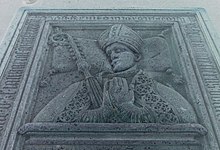Antipope Clement VIII
- Antipope Clement VIII should not be confused with Pope Clement VIII.
Clement VIII | |
|---|---|
 Tomb of Antipope Clement VIII in Palma Cathedral | |
| Papacy began | 10 June 1423 |
| Papacy ended | 26 July 1429 |
| Predecessor | Roman claimant: Martin V Antipapal (Avignonian) claimant: Benedict XIII |
| Successor | Roman claimant: Martin V Antipapal (Avignonian) claimant: Benedict XIV |
| Opposed to | Roman claimant: Pope Martin V Other claimant: Benedict XIV (Jean Carrier) |
| Other post(s) | Bishop of Mallorca |
| Personal details | |
| Born | Gil Sánchez Muñoz y Carbón 1369 |
| Died | 28 December 1445[1] or 1446[2] |
| Buried | Palma, Kingdom of Majorca |
| Nationality | Aragonese |
Clement VIII, born Gil Sánchez Muñoz y Carbón (1369/70 – 28 December 1445/46), was one of the antipopes of the Avignon obedience, reigning from 10 June 1423 to 26 July 1429. When King Alfonso V of Aragon reached an agreement with Pope Martin V, Sánchez Muñoz abdicated, made his submission and was appointed bishop of Mallorca.
Biography
[edit]Gil Sánchez was born in Teruel between 1369 and 1370.[3] He was a friend and advisor of the future Avignon anti-pope Benedict XIII, and member of the Avignon curia. In 1396 he was an envoy to the Bishop of Valencia to get Spanish support. Benedict had appointed four cardinals, and on his death, three of them, on 10 June 1423, elected Sánchez Muñoz as Pope.[1] The fourth, Jean Carrier, absent at the time, declared the election invalid, and elected his own antipope in turn, who took the name Benedict XIV. Consequently, Jean Carrier was excommunicated by Clement VIII.[4]
Clement VIII's fate was bound up with the ambitions of Alfonso V of Aragon. Alfonso wished to negotiate for Naples, and so gave Clement support; his queen Maria of Castile, and the Aragonese bishops supported Martin V. In the summer of 1423 Alfonso persuaded the Republic of Siena to acknowledge Clement VIII, thus securing recognition for the pope of the Avignon line in the very city, Pavia, which was part of the Republic of Siena,[dubious – discuss] where the Roman pope Martin V had convened an ecumenical council of the Church.[citation needed]
However, through the exertions of Cardinal Pierre de Foix, an able diplomat and relation of the King’s, an agreement was reached between Alfonso and the Pope.[2] Alfonso then sent a delegation in 1428 (headed by Alfonso de Borgia, the future Callixtus III), to persuade Clement to recognise Martin. Clement declared his abdication on 26 July 1429 and had his cardinals elect Oddone Colonna (Martin V) his successor, a formal act precluding future doubts concerning apostolic succession. His abdication was confirmed in mid-August. Clement had to make a penitential submission in forma to Martin V, and when this was done Martin granted Sánchez Muñoz the Bishopric of Mallorca.[5][6] Sánchez Muñoz died on 28 December 1445[1] or 1446.[2]
References
[edit]- ^ a b c Miranda, Salvador. "Antipope Clement VIII (1423-1429)", Cardinals of the Holy Roman Church, Florida International University
- ^ a b c One or more of the preceding sentences incorporates text from a publication now in the public domain: Hayes, Carlton Huntley (1911). "Clement s.v. Clement VIII.". In Chisholm, Hugh (ed.). Encyclopædia Britannica. Vol. 6 (11th ed.). Cambridge University Press. p. 486.
- ^ George L. Williams, Papal Genealogy: The Families And Descendants Of The Popes, (McFarland & Co. Inc., 1998), 234.
- ^ Michael J. Walsh, Lives of the popes: Illustrated biographies of every Pope from St Peter to the present, (Barnes & Noble Books, 1998), 183.
- ^ John-Peter Pham, Heirs of the Fisherman: Behind the Scenes of Papal Death and Succession, (Oxford University Press, 2004), 331.
- ^ mallorca web site. "Cathedral de Palma de Mallorca: La Seu". Mallorcawebsite.com. Retrieved 1 April 2017.
